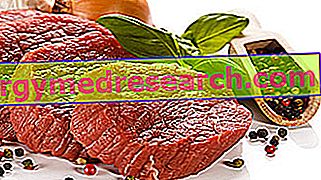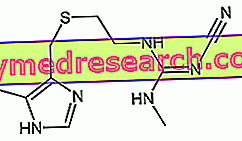Beef
Beef is a herbivorous animal belonging to the genus Bos, subgenus Bos, species Taurus ; the binomial nomenclature of beef is Bos taurus and there are various subspecies and races (see table).
| Dairy breeds | Italian | Italian Friesian, Italian Bruna |
| foreign | Black Spotted Friesian, Bruna Alpina, Ayrshire, Jersey | |
| Meat breeds | Italian | Chianina, Marchigiana, Romagnola |
| foreign | Charolaise, Limousine, Blonde d'Aquitaine, Aberdeen angus, Hereford | |
| Dual-purpose breeds | Italian | Italian Red Peppered, Piedmontese |
| foreign | Dutch Red Pepper, Simmenthal, Danish Red | |
| Unskilled breeds | Italian | Maremmana, Podolica, Reggiana |
| foreign | ||
| Italian native breeds locally bred | Maremmana, Podolica, Reggiana |
The common name of the Bos taurus is a domestic ox, while the term beef refers ONLY to male specimens, subjected to castration, aged between 1 and 4 years. Other names that indicate the Bos taurus of different sex, age and reproductive capacity, are: bull, ox, cow, manza, sorana, calf, calf, bullock etc.
| CATEGORY | DEFINITION |
| Calf-Heifer calf | Both male and female cattle from birth to weaning |
| heifer | Female cattle for reproductive career, from weaning up to 12/18 months of age that has NOT yet been conducted to the bull |
| Bullock | Both male and female cattle over a year old, destined for slaughter. |
| Manza | Female cow for a reproductive career, from one year of age to the first mating with a positive outcome, from 300 to 420-450 kg of live weight |
| Beef | Castrated male with a live weight over 350 Kg. NOTE: this category has disappeared from the production system in Italy; what is indicated by the butcher or in products packaged as beef is a bullock. |
| Ox | Adult male castrato used for work or meat production |
| Heifer or Manza Gravida | Female cattle during the first pregnancy |
| Cow | Female cattle from the first birth onwards (primipara, secondipara, etc.) |
| Torello | Male for reproduction until the first jump |
| Bull | male used for reproduction after the first jump. |
Bovine meat - Domestic beef
Beef is bred exclusively for meat; on the contrary, the female is destined mainly to reproduction and milk production, while the fertile male (bull) is used for reproduction.

Beef is generally fatter than veal; castration, in fact, favors the accumulation of fat, with a consequent productive and economic advantage. Furthermore, the taste is more decisive and the color of the meat is red, while the veal has lighter, tender meat with a delicate taste.
The beef, not very commercialized (as also that of bull and cow), is the fattest in the whole category. In Italy, beef is well rooted only in some Piedmont areas, where it is traditional to consume the Piedmontese boiled fat beef, slaughtered at 8-9 quintals.
The beef is divided into cuts, which in turn are separated from the quarters obtained from the two halves. Probably, the most famous ones are: the fillet, the loin and the "Fiorentina" steak (or loin with the fillet); however, on the whole the beef is differentiated into about 20 cuts which (for fatness and consistency) lend themselves to cooking and even quite different recipes. The parts defined as offal, together with the bones, constitute the well-known "fifth quarter"; of this group, the most commercialized types are: ossobuco, heart, liver, tongue and brain.
Contrary to what one might believe, beef is NOT much leaner than bred light pork; indeed, to be honest, considering the more "commercial" cuts of beef, it is often much fatter than a common fatless pork loin.
Gastronomic notes
Beef can be used in the formulation of various recipes, many of which are quite different from one another.
First of all for its fame and diffusion, grilled beef. The cuts that lend themselves most certainly are: loin, tenderloin and Florentine steak (loin + fillet); they do not disappoint even walnut and topside (with thinner pieces). That of grilled beef is undoubtedly the type of meat that lends itself more to cooking "to the blood", as it boasts a more pleasant taste and, as regards the hygienic aspect, the animal is less prone to parasitosis .
For the oven cooking, on the other hand, the cuts we mentioned above are certainly not the most correct solution. In general, beef does not lend itself much to this purpose, except for belly cuts. These are recipes with a very strong taste and that often do not satisfy the palate of those who love lean and delicate meats. The cooking is very long and, unlike the grilled one, must be TOTAL.
Fried beef is not one of the most popular recipes; unlike the bird products or the younger animals, this kind of food lends itself to the use of a strong oil, with a strong and full-bodied taste. It is necessary to carefully choose the cuts, which must be lean, without muscle sheaths and chopped to such a size as to allow rapid cooking to the heart of the product. Surface smearing may suffice but the most pleasing results are obtained with rosemary flavored breading.
Then we come to cooking in water; the beef is very suitable both for the structuring of the broth and for the formulation of the boiled meat. The favorite cuts are: the rump, the brisket and the neck (the important thing is that they are quite gelatinous). Recall that the broth and the boiled meat are NOT obtained by the same procedure; for the first, the pieces should be dipped in cold water, on the contrary, the boiled meat should be cooked by immersing it in boiling water. Both firings are very long and for the language it is necessary to apply a slightly different procedure (read the dedicated article).
Finally, we also mention the stracotture. Whether it is brazing, casserole cooking or stewing, beef always gives excellent results. The cuts indicated are more tenacious than those used in quick cooking, but less hard than those for boiled meat. They excel the priest's hat, the walker and the rump.
Slices of beef with green sauce
X Problems with video playback? Reload from YouTube Go to Video Page Go to Video Recipes Section Watch the video on youtubeNutritional Features
Beef has a different nutritional intake based on the specific cut. On average, these are foods with a medium lipid content, higher than that of veal but more limited than beef.
The prevalence of energy is almost always borne by the proteins (which are of high biological value), with some small exceptions inherent to the larger pieces, such as the belly and the brisket.
Carbohydrates and fibers are absent.
The breakdown of fatty acids is not bad, but neither is it exceptional; the amount of saturates is (roughly) the same as that of monounsaturates, while the polyunsaturates are in the minority. Cholesterol is present and not negligible.
As far as mineral salts are concerned, there is an excellent iron and potassium content; from a vitamin point of view, beef contains mainly vitamin PP (Niacin) and is an excellent source of vitamin B12 (cobalamin).
Beef is to be consumed in different portions depending on the specific cut, but always and however fluctuating between 150-250g. The frequency of consumption varies according to the global dietary context and it would be better not to exceed 2-3 times a week.
Beef can be inserted in any diet, paying attention to the lipid balance, total cholesterol intake and - in case of hypersensitivity - to the intake of purines. The subjects that need to pay more attention to the suitability of the portions of beef are: hypercholesterolemics and hyperuricemics.
However, let us remember that the abuse of meat (especially fat), associated with the lack of dietary fiber and other vegetable nutritional components, predisposes the body to the risk of hypercholesterolemia, atherosclerosis and colon cancer.
Nutritional values
Composition for 100g of Beef; Various Cuts - Reference values of the INRAN Food Composition Tables
| rib | Topside | fillet steak | Geretto | Walker | Sirloin steak | wot | Belly and P. chest | Rump | Silverside | Shoulder | Front cuts | Rear cuts | ||
| Edible portion% | 100 | 100 | 100 | 100 | 100 | 100 | 100 | 100 | 100 | 100 | 100 | 100 | 100 | |
| Water g | 71.6 | 75.2 | 72.7 | 75.0 | 74.9 | 72.3 | 75.4 | 69.0 | 73.8 | 74.6 | 75.2 | 72.0 | 74.0 | |
| Proteins g | 21.3 | 21.8 | 20.5 | 20.9 | 21.3 | 21.8 | 21.3 | 19.7 | 21.4 | 22.0 | 21.5 | 20.5 | 21.5 | |
| Amm. Preval. | B.C. Glut | B.C. Glut | B.C. Glut | B.C. Glut | B.C. Glut | B.C. Glut | B.C. Glut | B.C. Glut | B.C. Glut | B.C. Glut | B.C. Glut | B.C. Glut | B.C. Glut | |
| Limiting am | Trip | Trip | Trip | Trip | Trip | Trip | Trip | Trip | Trip | Trip | Trip | Trip | Trip | |
| Lipids TOT g | 6.1 | 1.8 | 5.0 | 3.2 | 2.8 | 5.2 | 2.3 | 10.2 | 3.7 | 2.6 | 2.4 | 7.0 | 3.4 | |
| B.C. g. saturated g | 2:03 | 0.60 | 1.67 | 1:07 | 0.93 | 1.73 | 0.77 | 3:21 | 1:23 | 0.87 | 0.76 | 2:20 | 1:14 | |
| B.C. g. mon. g | 1.99 | 00:59 | 1.63 | 1:04 | 0.91 | 1.69 | 0.75 | 3:31 | 1:20 | 0.85 | 0.78 | 2:27 | 1:12 | |
| B.C. g. pol. g | 1:21 | 00:36 | 0.99 | 0.64 | 00:56 | 1:03 | 00:46 | 2:27 | 0.74 | 00:52 | 00:53 | 1:55 | 0.68 | |
| Cholesterol mg | - | - | - | - | - | - | - | - | - | - | - | 59-72 | 52-68 | |
| Carbohydrates TOT g | 0 | 0 | 0 | 0 | 0 | 0 | 0 | 0 | 0 | 0 | 0 | 0 | 0 | |
| Glycogen g | 0 | 0 | 0 | 0 | 0 | 0 | 0 | 0 | 0 | 0 | 0 | 0 | 0 | |
| Sol sugars g | 0 | 0 | 0 | 0 | 0 | 0 | 0 | 0 | 0 | 0 | 0 | 0 | 0 | |
| Dietary fiber g | 0 | 0 | 0 | 0 | 0 | 0 | 0 | 0 | 0 | 0 | 0 | 0 | 0 | |
| Soluble g | 0 | 0 | 0 | 0 | 0 | 0 | 0 | 0 | 0 | 0 | 0 | 0 | 0 | |
| Insoluble g | 0 | 0 | 0 | 0 | 0 | 0 | 0 | 0 | 0 | 0 | 0 | 0 | 0 | |
| Kcal energy | 140 | 103 | 127 | 112 | 110 | 134 | 106 | 171 | 119 | 111 | 108 | 145 | 117 | |
| Sodium mg | 41 | 41 | 41 | 56 | 42 | 44 | 40 | 57 | 40 | 41 | 51 | 43 | 55 | |
| Potassium mg | 313 | 342 | 330 | 287 | 344 | 333 | 337 | 287 | 337 | 342 | 304 | 291 | 335 | |
| Iron mg | 1.3 | 1.8 | 1.9 | 1.4 | 1.4 | 1.4 | 1.3 | 1.1 | 1.3 | 1.8 | 1.5 | 1.3 | 1.6 | |
| Calcium mg | 4 | 4 | 4 | 5 | 4 | 4 | 4 | 6 | 4 | 4 | 6 | 10 | 4 | |
| Phosphorus mg | 172 | 214 | 200 | 175 | 175 | 178 | 200 | 168 | 180 | 206 | 200 | 180 | 190 | |
| Thiamine mg | 00:10 | 00:15 | 00:09 | 00:10 | 00:10 | 00:10 | 00:10 | 00:07 | 00:07 | 00:10 | 00:10 | 00:10 | 00:11 | |
| Riboflavin mg | 00:12 | 00:26 | 00:19 | 00:17 | 00:17 | 00:15 | 00:17 | 00:11 | 00:20 | 00:17 | 00:17 | 00:15 | 00:18 | |
| Niacin mg | 4:20 | 6:30 | 4.70 | 4:30 | 4:30 | 4.70 | 5:00 | 4.70 | 4.80 | 5:00 | 5:00 | 4.80 | 4.70 | |
| Vitamin A µg | tr | tr | tr | tr | tr | tr | tr | tr | tr | tr | tr | tr | tr | |
| Vitamin C mg | 0 | 0 | 0 | 0 | 0 | 0 | 0 | 0 | 0 | 0 | 0 | 0 | 0 | |
| Vitamin E mg | - | - | - | - | - | - | - | - | - | - | - | - | - | |



